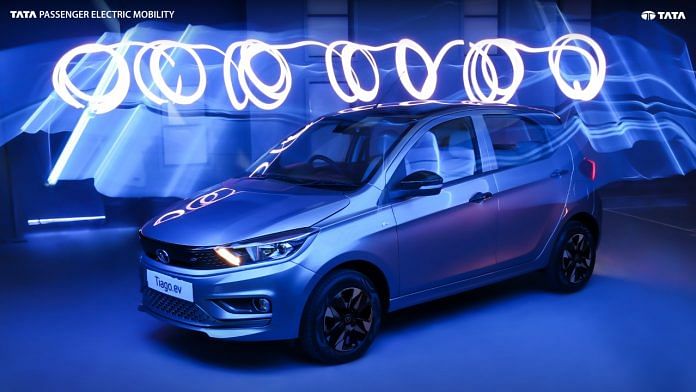In one of my Dashboard columns earlier this year, I had argued that your next car should be electric. In subsequent columns I have explored whether Hybrids make sense and also spoken about the infrastructural challenges of going electric. One of the challenges towards going electric, until now, was a lack of choice. But that is going to change dramatically in 2023.
Tata Motors dominates the electric passenger car market with the Nexon EV and Tigor EV, both among private car buyers and commercial operators. With a 90 percent market share and over 50,000 electric vehicles on the road, Tata Motors has used this position to strengthen its overall share in the Indian automotive market, even overtaking long-established number two Hyundai Motors in monthly sales a couple of times this year. Tata Motors has said that its EV brand will be quite imaginatively called ‘.EV’ with the sub-Rs 10 lakh Tiago.EV going on sale early in 2023, followed by (expected) electric versions of the Altroz hatchback and Punch SUV.
The EV year
Tata’s domestic rival Mahindra is launching the XUV400 in January as well. In fact, given the success of internal combustion engine vehicles in this particular sized segment, the XUV400 could help Mahindra beat Tata at its own game, especially as its ‘Born Electric’ vehicles are at least 18-24 months away.
But Tata won’t have it entirely its own way in 2023. In the affordable electric car segment, one will see the electric version of Citroen’s C3 hatchback come out early in 2023. The French carmaker has big plans for India and while sales of their internal combustion engine cars have been tepid, they are hoping that electrics can charge up sales. But the C3 and Tiago.EV will not be the smallest electric cars going on sale in 2023 — that will be the MG Air mini-car, a small urban runabout not much bigger than the erstwhile Tata Nano. The Chinese-owned carmaker also plans to bring in the much larger MG 4 in the EV segment, in a category larger than the current MG ZS EV.
Another Chinese firm, BYD is also dipping its toes in the Indian passenger car market with the Atto 3. BYD, with its unique ‘Blade’ battery that use Lithium Ferro-Phosphate (LFP) cells also used by Mercedes-Benz and Toyota, might not be aiming for market domination, but it would certainly hope that Atto 3 will be able to compete with the likes of the second-generation Hyundai Kona. Indeed, 2023 will be a big year for India’s second-largest carmaker with the award-winning IONIQ5 electric car going on sale in February and then IONIQ6 likely later this year.
Hyundai’s sister-firm Kia might have no plans to launch a ‘new’ electric vehicle in 2023 but will start local assembly of the EV6, which ought to bring down prices of the smart Korean car. Talking of sister concerns, both Skoda and Volkswagen plan to start electric vehicle sales in the new year. While the new Skoda Enyaq has already been tested on Indian roads, Volkswagen might bring the ID.3 and ID.4 vehicles to India.
Also read: For Indian buyers, Hybrids can be pitstop. EVs still the future
Luxury EV
However, the biggest—and some could argue the best—electric vehicles coming to India will be in the luxury segment. While there are no plans for Elon Musk to bring in the Tesla brand to India, with lobbying efforts to reduce import taxes on fully built cars having failed, the German trio of Audi, BMW and Mercedes-Benz is doubling down on their offerings.
The first big play will be the new BMW i7, the electric version of the new BMW 7-series, which feels like a spaceship inside. Audi is expected to bring the e-tron version of the Q8 SUV and there is a likelihood of the Q4 e-tron as well. This will be the second generation of Audi’s pioneering e-tron technology. Mercedes-Benz, which has already started to make the EQS sedan at its Chakan plant in Pune, Maharashtra, will also be bringing in the EQE sedan as well as the SUV body styles on their EQS. Audi and BMW are also expected to follow Mercedes-Benz’ lead and start assembling electric vehicles in India.
In addition, there has been a dramatic improvement in the availability of public charging infrastructure across the country. Alternating Current (AC) chargers are available almost everywhere, even in the high Himalayas and the deserts of Rajasthan while most major Indian expressways and highways have multiple high-speed Direct Current (DC) chargers at regular intervals.
Very fast DC chargers that operate at 90-180 kilowatt hours (kWh) that could charge some of the latest cars in under half an hour are still rare and much work remains to be done at the back-end. Also, commercial power remains quite expensive with average cost of around Rs 25 per unit. To benefit from the cost advantage of electric vehicles, of any kind, on two or four wheels, home charging is a necessity, but for that, investments need to be made in the grid, which are finally happening.
I would like to take this opportunity to wish all my regular readers, and those who have stumbled onto this column (I hope you stay for more, as you can see 2023 will be exciting) as well as all readers and supporters of The Print a very prosperous 2023.
@kushanmitra is an automotive journalist based in New Delhi. Views are personal.
(Edited by Prashant)






